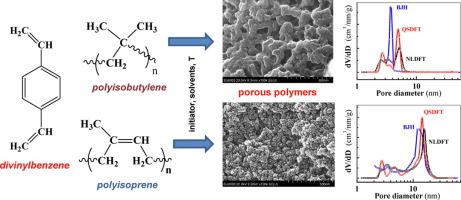当前位置:
X-MOL 学术
›
Eur. Polym. J.
›
论文详情
Our official English website, www.x-mol.net, welcomes your feedback! (Note: you will need to create a separate account there.)
Mesoporous polymer systems based on divinylbenzene copolymers modified with linear rubbers
European Polymer Journal ( IF 6 ) Pub Date : 2020-02-01 , DOI: 10.1016/j.eurpolymj.2020.109480 Alexander Pastukhov
European Polymer Journal ( IF 6 ) Pub Date : 2020-02-01 , DOI: 10.1016/j.eurpolymj.2020.109480 Alexander Pastukhov

|
Abstract Porous polymer systems based on divinylbenzene copolymers modified with co-monomers (ethylvinylbenzene, methyl acrylate, methacrylic acid) and linear rubber macromolecules (polybutadiene, polyisoprene, polyisobutylene, polystyrene-butadiene, polyacrylonitrile-butadiene) were investigated. The copolymers in the form of spherical beads were synthesized by radical suspension polymerization of monomer compositions with appropriate porogenic organic solvents. It was found that modification of the divinylbenzene copolymers by linear rubbers enables the synthesis of sorbents with a controlled fractional composition of micro- and mesopores. A universal method is suggested for a quantitative estimation of fractional pore size distribution in the range of micro and mesopores from the data of low-temperature nitrogen sorption. Calculations of integral and differential distributions are based on using methods of quenched solid density functional theory (QSDFT), non-local density functional theory and the Barrett-Joyner-Halenda method based on capillary condensation theory. According to QSDFT calculations, the porous system of sorbents contains three groups of pores of certain sizes: 1.7–3.3, 3.3–6.6 and 8.4–40 nm. Upon introduction of polyisoprene into the polymer system the sorbent containing primarily 8–24 nm mesopores is obtained; upon the introduction of polyisobutylene, the sorbent with pore sizes of 4–6 nm is synthesized. The volume and surface area of micropores in the copolymers with polyisoprene and polyisobutylene may be increased by extracting a part of the rubber phase with toluene. Specific surface area of the copolymers varies in the range of 230–570 m2 g−1. Scanning electron microscopy studies of the porous structure of the polymer systems showed that in the copolymers with polybutadiene the porous structure is formed by the aggregates of globules 20–60 nm. The copolymer with polyisobutylene has a 3D skeletal structure with 100–200 nm voids.
中文翻译:

基于线性橡胶改性的二乙烯基苯共聚物的介孔聚合物体系
摘要 研究了基于共聚单体(乙基乙烯基苯、丙烯酸甲酯、甲基丙烯酸)和线性橡胶大分子(聚丁二烯、聚异戊二烯、聚异丁烯、聚苯乙烯-丁二烯、聚丙烯腈-丁二烯)改性的二乙烯基苯共聚物的多孔聚合物体系。球形珠粒形式的共聚物通过单体组合物与合适的致孔有机溶剂的自由基悬浮聚合合成。发现通过线性橡胶对二乙烯基苯共聚物的改性能够合成具有受控的微孔和中孔分数组成的吸附剂。提出了一种通用方法,用于根据低温氮吸附数据定量估计微孔和中孔范围内的部分孔径分布。积分和微分分布的计算基于使用淬火固体密度泛函理论 (QSDFT)、非局部密度泛函理论和基于毛细管冷凝理论的 Barrett-Joyner-Halenda 方法。根据 QSDFT 计算,吸附剂的多孔系统包含三组特定大小的孔:1.7-3.3、3.3-6.6 和 8.4-40 nm。将聚异戊二烯引入聚合物体系后,获得主要含有 8-24 nm 中孔的吸附剂;在引入聚异丁烯后,合成了孔径为 4-6 nm 的吸附剂。通过用甲苯萃取部分橡胶相可以增加聚异戊二烯和聚异丁烯共聚物中微孔的体积和表面积。共聚物的比表面积在 230–570 m2 g-1 的范围内变化。聚合物体系多孔结构的扫描电子显微镜研究表明,在与聚丁二烯的共聚物中,多孔结构是由 20-60 nm 的小球聚集体形成的。与聚异丁烯的共聚物具有 3D 骨架结构,具有 100-200 nm 的空隙。
更新日期:2020-02-01
中文翻译:

基于线性橡胶改性的二乙烯基苯共聚物的介孔聚合物体系
摘要 研究了基于共聚单体(乙基乙烯基苯、丙烯酸甲酯、甲基丙烯酸)和线性橡胶大分子(聚丁二烯、聚异戊二烯、聚异丁烯、聚苯乙烯-丁二烯、聚丙烯腈-丁二烯)改性的二乙烯基苯共聚物的多孔聚合物体系。球形珠粒形式的共聚物通过单体组合物与合适的致孔有机溶剂的自由基悬浮聚合合成。发现通过线性橡胶对二乙烯基苯共聚物的改性能够合成具有受控的微孔和中孔分数组成的吸附剂。提出了一种通用方法,用于根据低温氮吸附数据定量估计微孔和中孔范围内的部分孔径分布。积分和微分分布的计算基于使用淬火固体密度泛函理论 (QSDFT)、非局部密度泛函理论和基于毛细管冷凝理论的 Barrett-Joyner-Halenda 方法。根据 QSDFT 计算,吸附剂的多孔系统包含三组特定大小的孔:1.7-3.3、3.3-6.6 和 8.4-40 nm。将聚异戊二烯引入聚合物体系后,获得主要含有 8-24 nm 中孔的吸附剂;在引入聚异丁烯后,合成了孔径为 4-6 nm 的吸附剂。通过用甲苯萃取部分橡胶相可以增加聚异戊二烯和聚异丁烯共聚物中微孔的体积和表面积。共聚物的比表面积在 230–570 m2 g-1 的范围内变化。聚合物体系多孔结构的扫描电子显微镜研究表明,在与聚丁二烯的共聚物中,多孔结构是由 20-60 nm 的小球聚集体形成的。与聚异丁烯的共聚物具有 3D 骨架结构,具有 100-200 nm 的空隙。



























 京公网安备 11010802027423号
京公网安备 11010802027423号